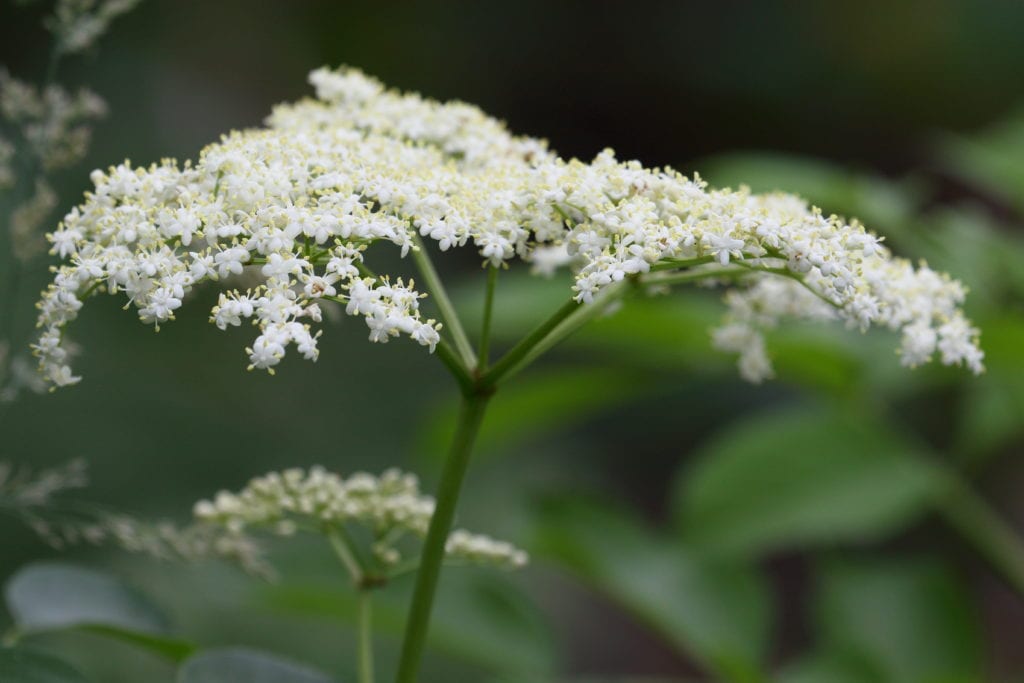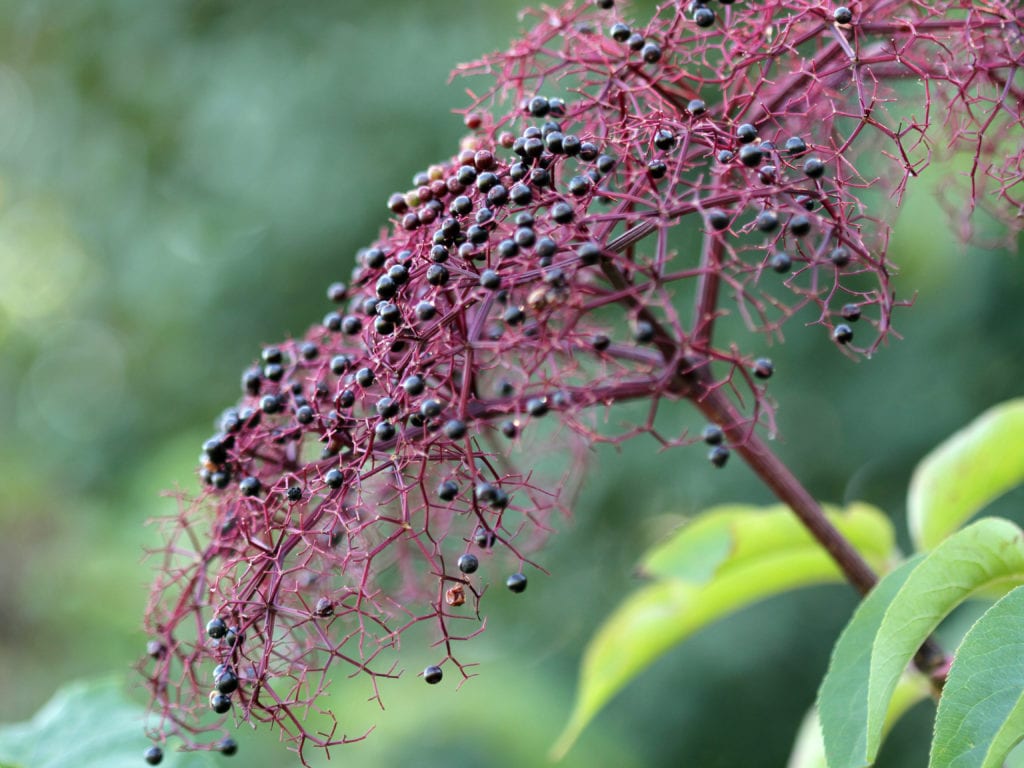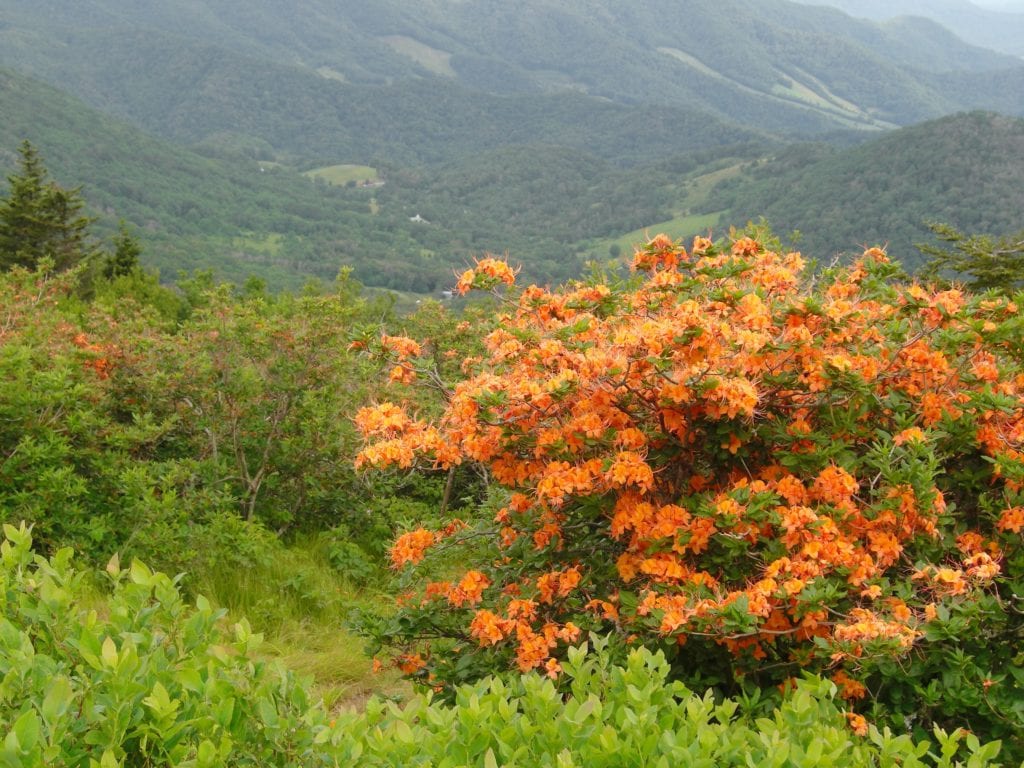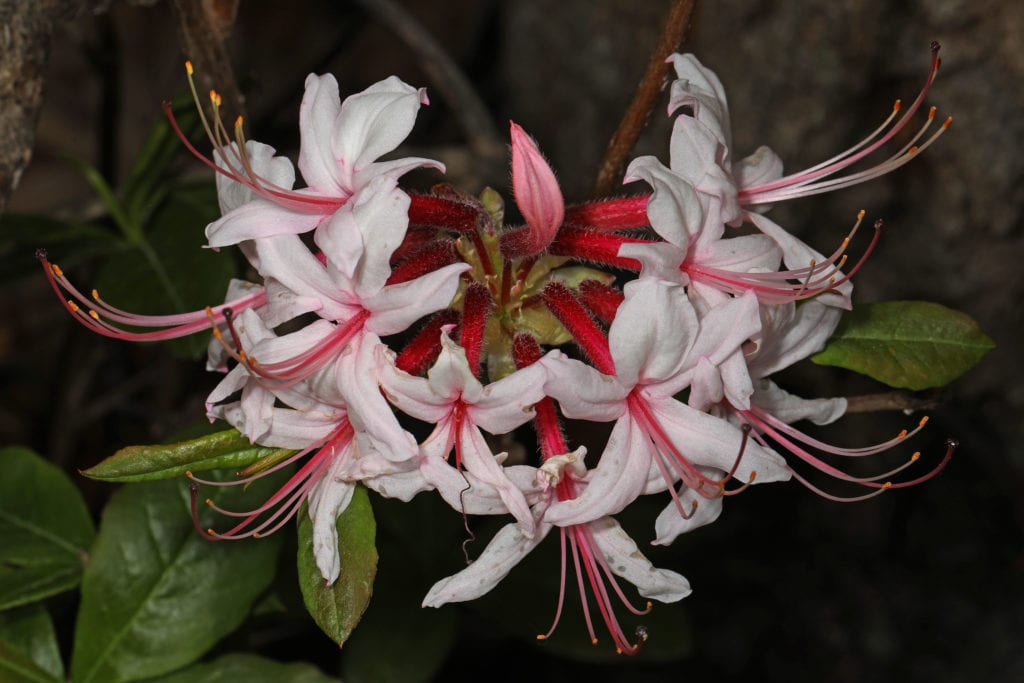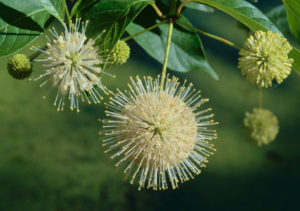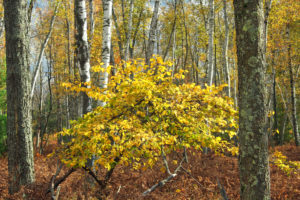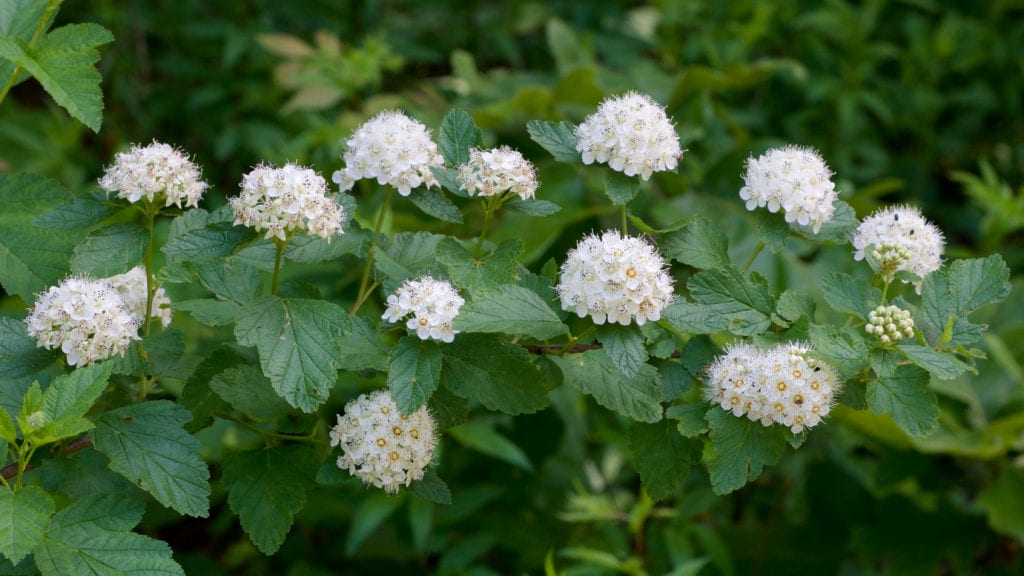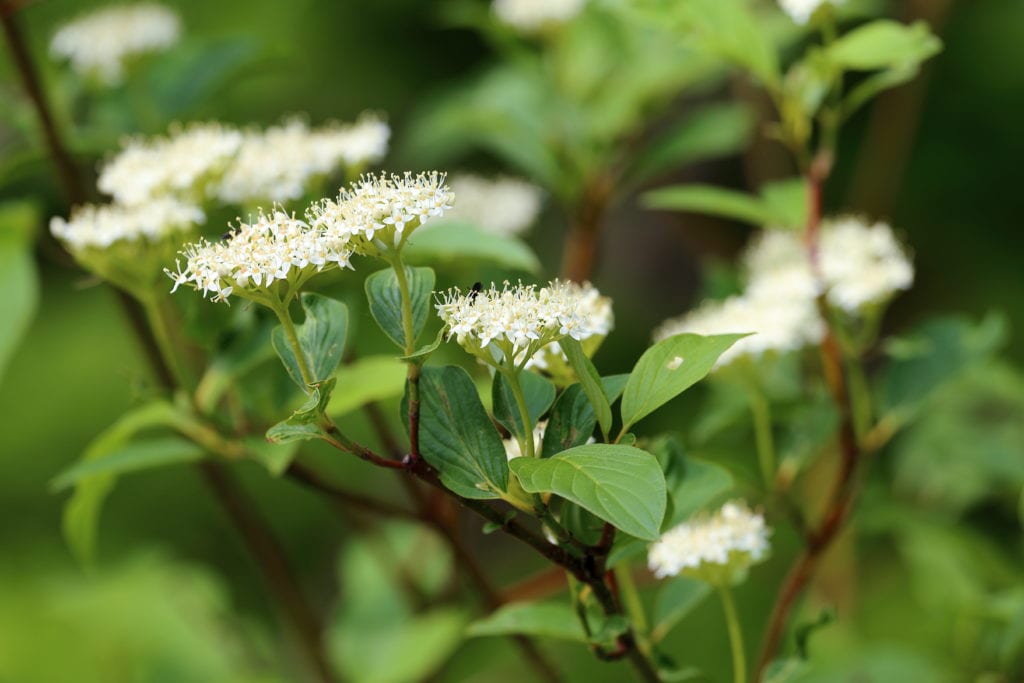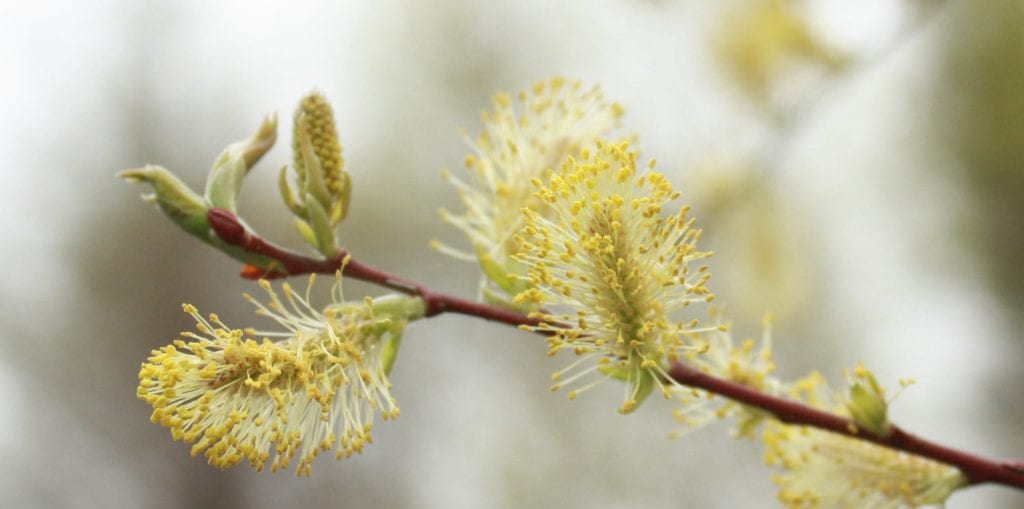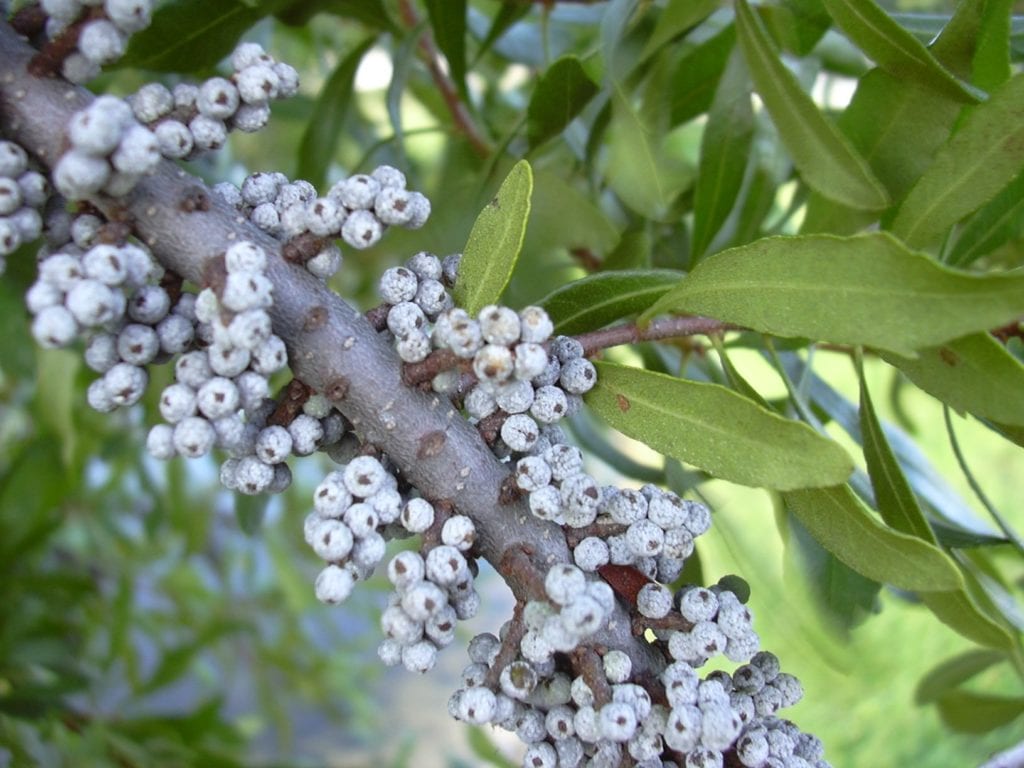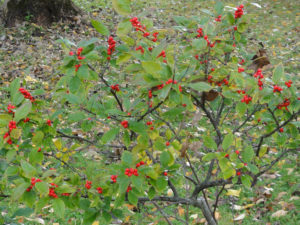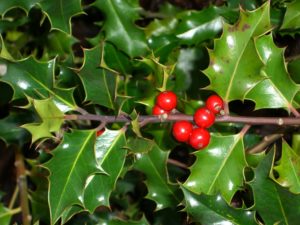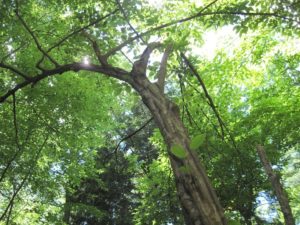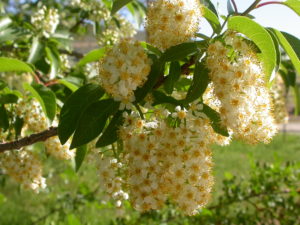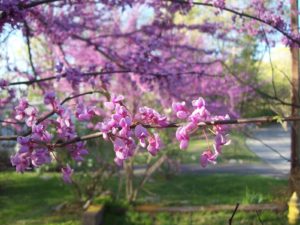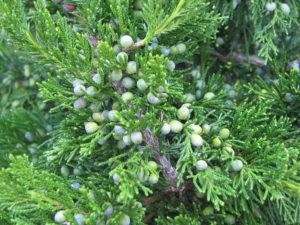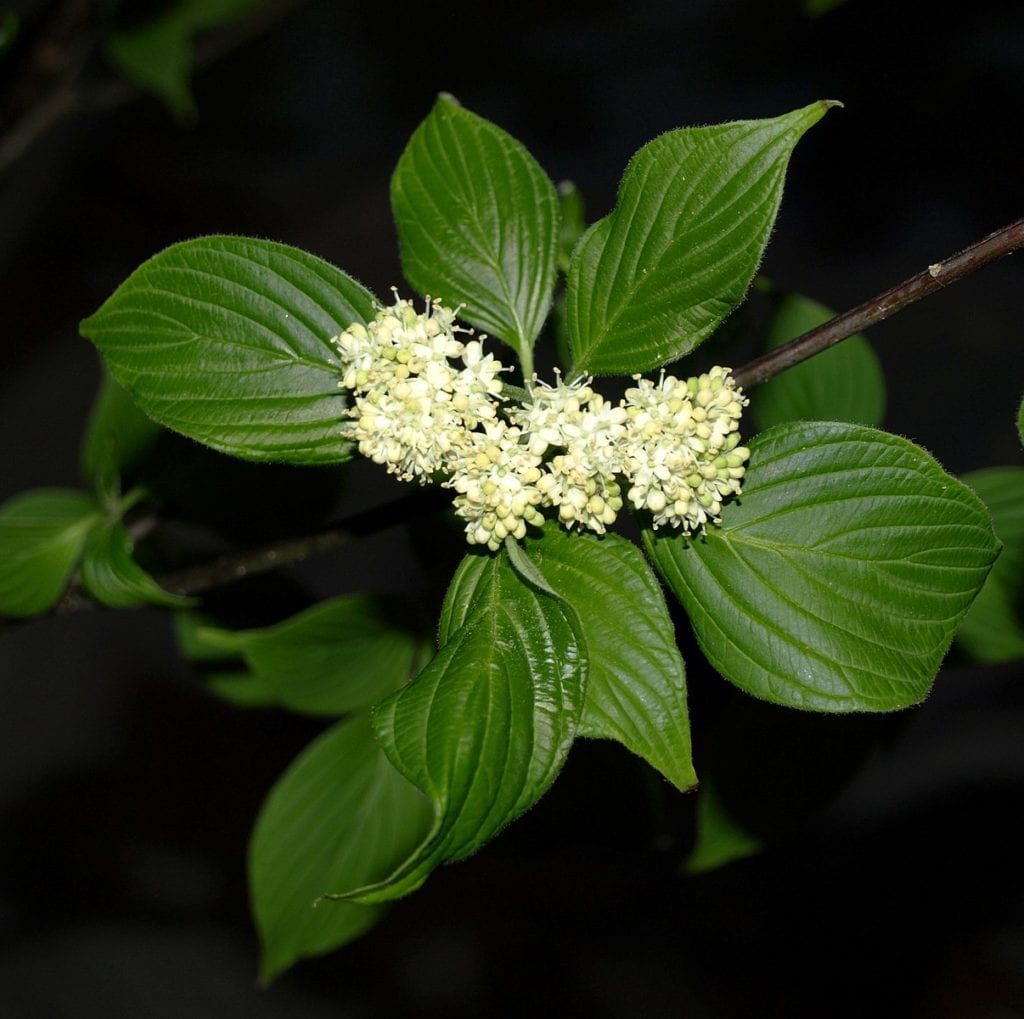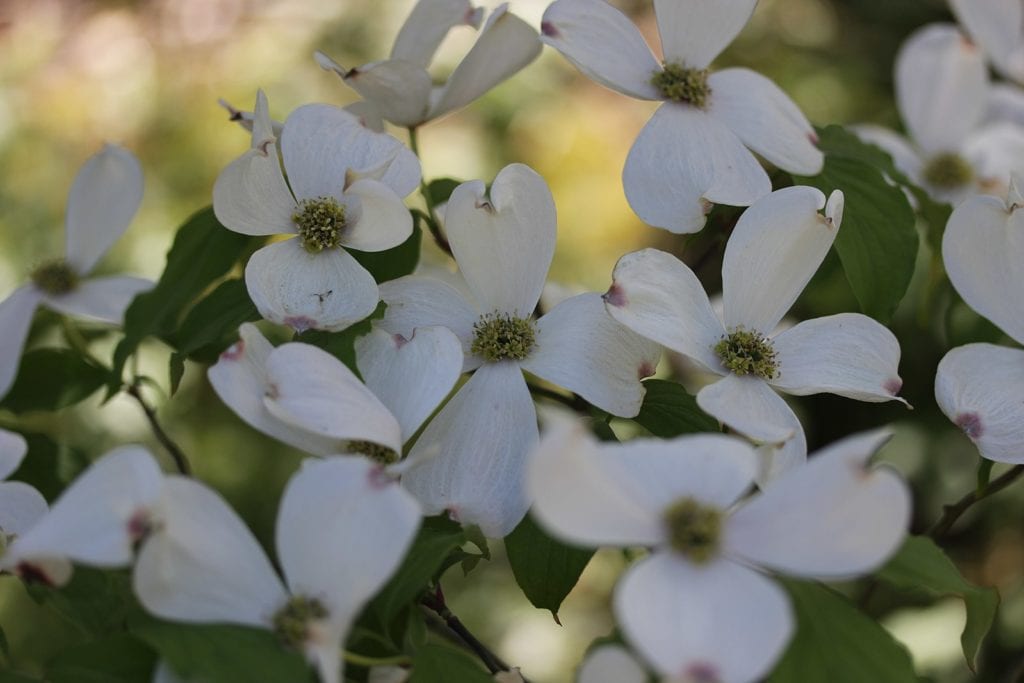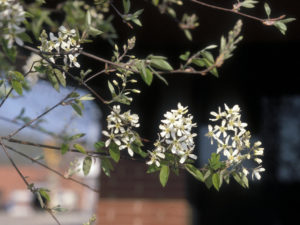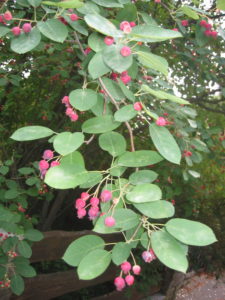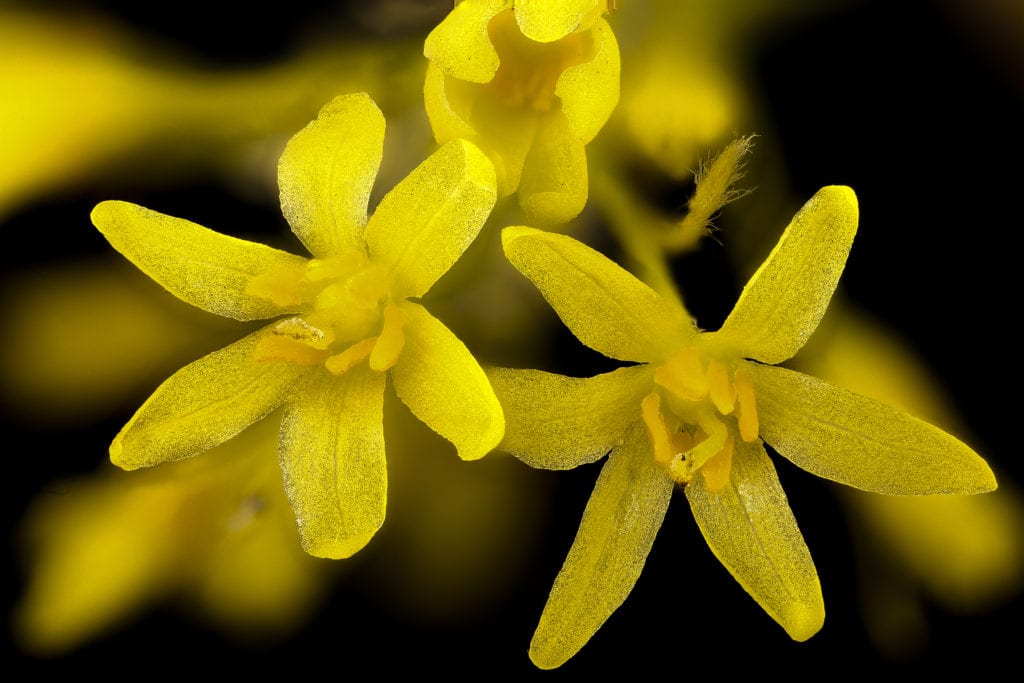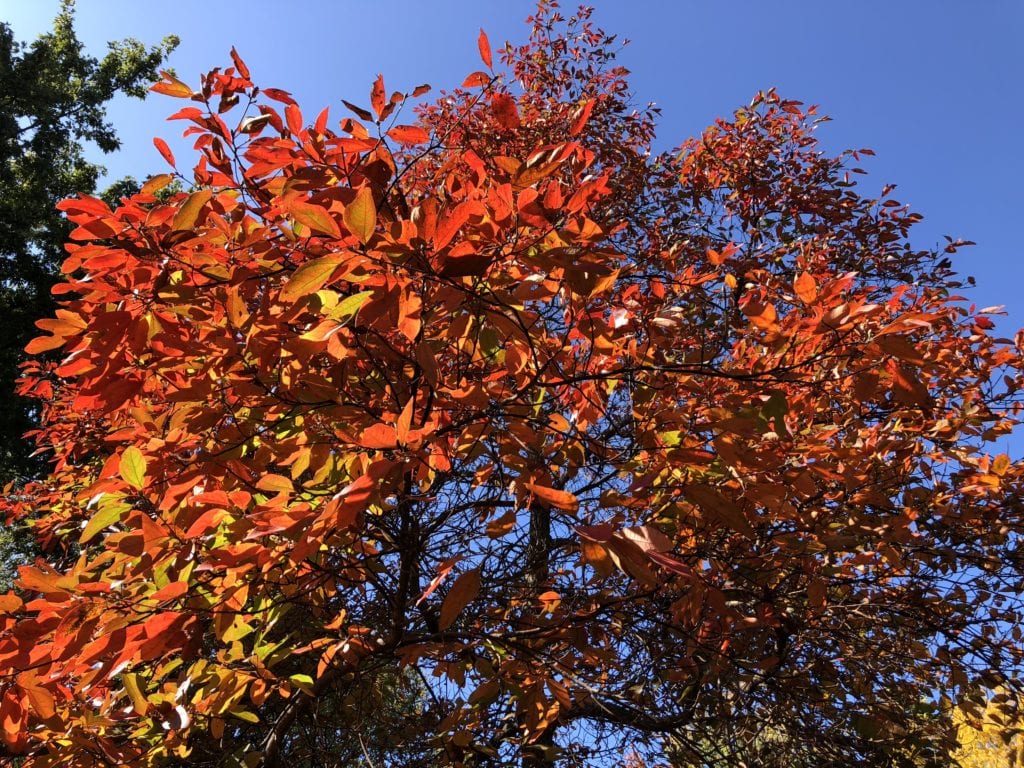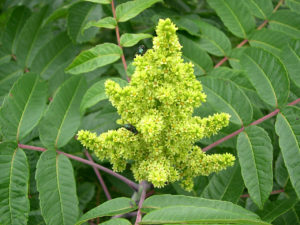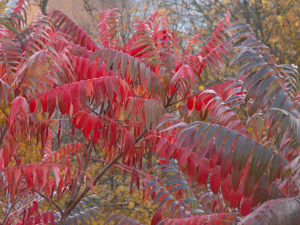By Sarah W. Middeleer, ASLA
Large shrubs and small trees constitute a rich, varied category with many uses, and this article will explore some of those native to the Northeast. Although not every group member has an obvious non-native correlate to replace them, many of these plants are so desirable that they deserve to be the first choice for any design given appropriate growing conditions.
A common admonition among proponents of ecological gardening is to reduce lawn areas and add native plants. Native shrub borders are lower maintenance than perennial borders, making them an excellent solution to this challenge. The plants in this category often provide multi-season interest, including showy flowers, fruit, and fall foliage.
Large shrubs and small trees are also valuable for bridging the transition from the ground plane to the shade-tree canopy. Often, I see expanses of lawn bordered by tall trees, which lack the visual interest and wildlife value of more layered plantings. In addition, larger shrubs can effectively frame spaces and provide a “hide and reveal” effect. Finally, small trees are invaluable to the residential landscape because their scale suits smaller spaces and poses less threat to structures in severe weather.
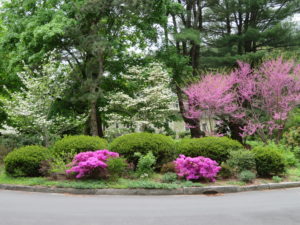
Traffic Island in Lexington MA planted with native Cornus florida and Cercis canadensis makes a beautiful spring show. Photo by Greta Ljung.
Older literature will often describe many of the native plants listed below as “suitable for naturalizing.” But I feel that, with the proper care and placement, these plants can add tremendous beauty and ornamental value to any outdoor space, given the appropriate growing conditions. However, the benefits to beneficial insects and birds offered by these plants are perhaps their best features.
Large Shrubs
American Elderberry (Sambucus canadensis) 5’–12’ h x 5’–12’ w; full sun to part shade; water medium to wet. Lemon-scented, white flowers that attract pollinators in June develop into black fruits highly prized by wildlife and people (for syrups, desserts, and wine). Elderberry attracts 40 species of native Lepidoptera (butterflies and moths). It prefers moist soil and will sucker, making it useful as a screen, hedge, background planting, and good in rain gardens. Some gardeners advocate cutting it back severely in spring. With shaping, it could make a good substitute for mock-orange (Philadelphus coronarius) and white lilac (Syringa vulgaris v. ‘alba’).
- Sambucus canadensis (common elderberry) in flower. Photo credit Cephas Wikimedia Commons.
- Sambucus nigra ssp canadensis (common elderberry) in fruit. Photo credit Cmeusburger Wikimedia Commons.
American Hazelnut (Corylus americana)10’–16’ h x 8’–13’ w; full sun to part shade; water medium. This native filbert offers edible nuts and good fall color but is also very valuable to wildlife, supporting pollinators, birds, and mammals. It attracts 124 species of native Lepidoptera. Male and female flowers appear on the same plant; male flowers are showy catkins favored by many birds. Use instead of European filbert, Corylus avellana.
Azaleas (Rhododendron spp.) The deciduous azaleas are excellent garden plants. These shrubs attract hummingbirds and butterflies, and some bloom when many other woodland plants have finished flowering. They attract 50 species of native Lepidoptera. Use in place of non-native azaleas and hydrangeas. Good in masses and combining with native evergreens.
- Rhododendron calendulaceum (flame azalea) Photo credit Jason Hollinger Wikimedia Commons
- Rhododendron periclymenoides(Pinxterbloom Azalea) Photo credit Judy Gallagher Wikimedia Commons.
- Flame Azalea (R. calendulaceum) 4’–8’ h x 8’–10’ w; part shade; water med; flowers yellow to orange to red, May-July.
- Pinxterbloom Azalea (R. periclymenoides) 3’–6’ h x 4’–7’ w; full sun to part shade; water med; flowers white or pink, fragrant, April-May.
- Roseshell Azalea (R. prinophyllum) 4’–8’ h x4’–8’ w; part shade; water med; flowers pink, fragrant, April-May.
- Swamp Azalea (R. viscosum) 3’–5’ h x 3’–5’ w; part shade; water med to wet; flowers white to pale pink, fragrant, May-July.
Buttonbush (Cephalanthus occidentalis) 5’–10’ h x 4’–8’ w; full sun to part shade; water medium to wet. The showy, fragrant white flowers of this shrub attract hummingbirds and butterflies and develop into nutlets that support birds. Buttonbush attracts 19 species of native Lepidoptera. It tolerates wet soils but adapts to various soil types except for dry ones. Use instead of the invasive European snowball viburnum (Viburnum opulus).
- Cephalanthus occidentalis (butttonbush) Photo credit The Cosmonaut Wikimedia Commons.
- Hamamelis virginiana(witchhazel) Photo credit Nicholas A. Tonelli Wikimedia Commons.
Common Witchhazel (Hamamelis virginiana) 15’–20’ height and width; full sun to part shade; water med. This lovely member of the woodland understory produces golden, delicate, fragrant flowers in the fall, which develop into seeds that explode from their pods the following autumn. Fall color is yellow and reliably good. Witch hazel will sucker, but its beauty and value to wildlife make it a standout nonetheless. It attracts 62 species of Lepidoptera. Use in place of Cornelian cherry dogwood (Cornus mas).
Dogwoods (Cornus spp.) There are two native dogwood trees (see in Small Trees, below) and several valuable dogwood shrubs. In their native habitat, these dogwoods grow in moist lowlands, but they also tolerate typical garden soils. They may sucker. Redtwig and gray dogwoods bear reddish stems, particularly on younger wood. All of these plants support pollinators and birds, as well as 115 species of native Lepidoptera. Given enough room to extend their arching stems, these dogwoods are lovely as specimens or in small groups. Use instead of nonnative viburnums and the invasive false spirea (Sorbaria sorbifolia).
- Gray Dogwood (C. racemosa) 10’–15’ height and width; full sun to part shade; water med; white fruit; tolerates poor soil and hot sites.
- Red Twig Dogwood (C. sericea) 6’–9’ h x 7’–10’ w; full sun to part shade; water med to wet; white berries.
- Silky Dogwood (C. amomum) 6’–12’ height and width; full sun to part shade; water med to wet; showy blue fruit.
- Physocarpus opulifolius(ninebark) Photo credit AnRo0002 Wikimedia Commons.
- Cornus sericea (red-twig dogwood) Photo credit Cephas Wikimedia Commons.
Ninebark (Physocarpus opulifolius) 5-8’ h x 4-6’ w; full sun to part shade; water dry to med. This spirea cousin has white to pink flowers in flat-topped clusters May-June that give way to reddish seed capsules. The showy, exfoliating bark is responsible for its common name. Ninebark tolerates a wide range of conditions, including drought, and attracts many birds and pollinators. It attracts 35 species of Lepidoptera. Use instead of Japanese spireas.
Northern Bayberry (Myrica pensylvanica) 5-10’ height and width; full sun to part shade; water dry to med. Often found near the shore, bayberry withstands salt spray and shade. Bayberry’s fragrant berries are used to scent soaps and candles. This shrub is of value to birds for its winter-persistent fruit, which is blue-gray and borne by female plants and attracts 106 species of Lepidoptera. Bayberries can sucker. Use as a screen in combination with evergreens or as a backdrop to plants with colorful flowers.
- Salix discolor(pussy willow) Photo credit Silk666 Wikimedia Commons.
- Myrica pensylvanica(Northern bayberry) Photo credit Kim Starr Wikimedia Commons.
Pussy willow (Salix discolor) 6-15’ h x 4-12’ w; full sun to part shade; water med to wet. In the wild, pussy willow grows in wet areas but will tolerate drier (but not very dry) soils. Male plants produce the beloved, showy catkins, for which the plant is named, in late winter/early spring. Pussywillows offer many benefits to wildlife, which helps to offset its somewhat coarse quality when not in bloom. This genus attracts 440 species of Lepidoptera. Use in place of goat willow (Salix caprea)and combine with other plants that are more ornamental later in the season.
Rosebay Rhododendron (R. maximum) 5-15’ h x 5-12’ w; part shade to full shade; water med. This broadleaf evergreen bears flowers June-July in shades that can range from very pale pink to purplish. It attracts butterflies, caterpillars, hummingbirds, and other birds, and 50 species of Lepidoptera. It also offers cover to birds from winter cold and predators. Provide rosebay with moist but well-drained, humusy, acidic soil. Very effective in masses or combined with other woodland shrubs. Use in place of non-native rhododendrons.
Viburnums (Viburnum spp.) This large genus contains many valuable native shrubs. They all boast showy white flowers and fruits that birds love. This genus also attracts 97 species of native Lepidoptera. Many viburnums offer striking fall colors.
- Northern Arrowwood (V. dentatum) 6-10’ height and width; full sun to part shade; water med. White flowers May-June lead to blue-black fruits. Attracts birds and butterflies—variable fall color.
- Hobblebush (V. lantanoides) 9-12’ height and width; part shade; water med to wet. White flowers in May develop into red fruit that ripens to black. Excellent red fall color. Dirr describes it as “somewhat scraggly.”
- Nannyberry (V. lentago) 14-16’ h x 6-12’ w; full sun to part shade; water med. White flowers in May produce berries that turn from red to black. Variable fall color but can be excellent red. It can be grown as a single-stem tree to 30’.
- Smooth Witherod (V. nudum) 5-12’ height and width; full sun to part shade; water med to wet. White, fragrant flowers produce berries that start pink and end up blue-black, sometimes displaying the full-color range in the same cluster at one time. Excellent fall color.
Winterberry (Ilex verticillata) 3-12’ height and width; full sun to part shade; water med to wet. Winterberry, a deciduous holly, requires a male plant in the vicinity to help pollinate the female (one male can serve six or so females), which will result in a brilliant, cheery display of red berries in winter. Winterberry asks very little of the gardener, being adaptable to a variety of conditions. It attracts pollinators, birds, and over 96 species of native Lepidoptera. Like most plants adapted to wetlands, its leaves emerge in late spring. Use in place of Japanese barberry.
- Ilex verticillata (winterberry) Photo credit R. A. Nonenmacher Wikimedia Commons.
- Ilex opaca (American holly) Photo credit Kristina D.C. Hoeppner Wikimedia Commons.
Small Trees
American Holly (Ilex opaca) 15-30’ h x 10-20’ w; full sun to part shade; water med. American holly is best known for its bright red fruit on female plants and spiny, evergreen leaves, making it a favorite in holiday decorations. But birds love the fruit too, and the genus attracts almost 100 species of native Lepidoptera. American holly needs acidic, well-drained soil and protection from harsh winter winds. It is handsome in front of conifers (but give it ample sun) and can make an attractive specimen as well. Use in place of non-native hollies.
American Hophornbeam (Ostrya virginiana) 25-40’ h x 10-15’ w; full sun to part shade; water med to dry. Hophornbeam is a graceful tree with horizontal or drooping branches. Its flowers are catkins, and its fruit a nutlet in a casing that resembles that of hops. Fall color is yellowish. Hophornbeam attracts birds and 91 species of Lepidoptera. Use in place of European or Japanese hop hornbeams.
American Hornbeam (Carpinus caroliniana) 20-35’ height and width; part shade to full shade; water med. Also called musclewood, this handsome tree’s smooth, gray trunk and mature branches develop a muscled appearance. It prefers deep, rich, moist soils and shade, often growing along woodland streams–although Dirr mentions its adaptability to locations such as shopping center islands. Another catkin producer, hornbeam’s nutlets, are highly attractive to birds and other animals. It also attracts more than 60 species of Lepidoptera. Fall color can range from yellow to orange and red. It can be pruned into a hedge. Use instead of non-native hornbeams.
- Carpinus caroliniana (American hornbeam) Photo credit Rob Duval Wikimedia Commons.
- Prunus_virginiana_ (chokecherry) Photo credit Matt Lavin Wikimedia Commons.
Chokecherry (Prunus virginiana) 20-30’ h x 15-20’ w; full sun to part shade; water med. This small tree bears fragrant white flowers in spring, luring pollinators, and then produces fruit that turns from red to black and persists in winter, attracting many birds. This genus supports 429 species of Lepidoptera. The gold to orange fall color is reliably good—Dirr comments on chokeberry’s remarkable ability to grow in very scant, dry soil.
Eastern Redbud (Cercis canadensis) 20-30’ h x 25-35’ w; full sun to part shade; water med. Eastern redbuds are deservedly popular for their early spring, magenta flowers, and rounded, spreading form. It does best in consistently moist but well-drained soils. Although redbud appears in all of New York and north into Canada, it isn’t native to Vermont, New Hampshire, or Maine (BONAP). Flowers develop into short, pendulous brown seed pods. Redbuds attract birds and pollinators and 19 species of native Lepidoptera. Use instead of ornamental cherries.
- Cercis canadensis( Eastern redbud) Photo credit Hoodedwarbler 12 Wikimedia Commons.
- Juniperus virginiana(Eastern red cedar) Photo credit David J. Stang Wikimedia Commons.
Eastern Red Cedar (Juniperus virginiana) 40-50’ h x 8-20’ w; full sun; water dry to med. Eastern red cedar is a needled evergreen that easily adapts to a wide variety of soils and conditions except for wet areas. The bark is reddish-brown and exfoliates in strips. Female cedars produce handsome, gray-green berry-like cones that many birds devour. But cedars offer benefits to many other insects and animals as well (91 species of native Lepidoptera.) When planted near shrubs and trees in the rose family (Prunus, Malus, Rosa, etc.), cedar apple rust may affect them. Use instead of non-native junipers as specimens, in groups, or for screening.
Dogwoods (Cornus spp.)Flowering Dogwood (C. florida) 15-30’ height and width; full sun to part shade; water med.This beautiful tree blooms in April-May. Its pollinator-friendly flowers are small and green, surrounded by wide-spreading, milky-white bracts. Flowers develop into handsome red drupes loved by birds. The genus attracts 115 species of native Lepidoptera. Fall foliage is dependably dark red. Flowering dogwood can be susceptible to anthracnose and other problems, but if the trunk is protected from weed whackers and the root system is kept cool by mulch or ground cover, flowering dogwood will thrive. It enjoys an eastern exposure or dappled shade. Use in place of a handkerchief tree (Davidia involucrata).
- Cornus alternifolia (Pagoda dogwood) Photo credit Environmental Protection Agency Wikimedia Commons.
- Cornus florida (flowering dogwood) Photo credit Bjorn S… Wikimedia Commons.
Pagoda Dogwood (C. alternifolia) 15-25’ h x 20-30’ w; full sun to part shade; water med. The branches of pagoda dogwood are whorled and spread horizontally, providing an unusual, striking habit. Its creamy-white, highly fragrant flowers appear in spring and develop into green fruits that turn red and then purple, with attractive red stems. Fall foliage is reddish. Dirr notes that a canker can kill larger pagoda dogwoods and that this tree does best in cool-summer areas. Use instead of Kousa dogwood.
Prickly Ash (Zanthoxylum americanum) 15-20’ h x 10-15’ w; full sun to part shade; water med. This member of the citrus family has sharp spines on its leaves. Flowers are not showy but are fragrant, as are the bark, stems, and leaves, and they attract butterflies and bees. (Prickly ash is a preferred host for giant swallowtail butterflies, which are uncommon in New England but do appear.) It also attracts three other species of native Lepidoptera. Red fruits appear on female plants and are very attractive to birds. The fall color is yellow. Use in place of non-native prickly ashes.
Serviceberries (Amelanchier spp.) Sometimes difficult to tell apart, all of the serviceberries are beautiful additions to the landscape wherever the conditions are right. Their fluttering leaves turn orange and scarlet in fall; showy white flowers; and attractive, edible fruits are hard to resist. If you have redbud, serviceberry, and flowering dogwood in your garden, the spring bloom sequence will delight humans and serve early emerging pollinators. (Try to harvest some of the berries before the birds devour them.) Sometimes grown as single-stem trees, they are usually multi-stemmed. The graceful architecture of their pale-gray branches even adds beauty to the garden at night. Suppose one should be so lucky to have redbud, serviceberry, and flowering dogwood in the same garden. In that case, the sequence of spring blooms will not only be delightful but will serve early emerging pollinators. The genus supports 15 species of Lepidoptera. All species take full sun to part shade and a moderate amount of water. Avoid close proximity with Eastern red cedar due to the possibility of cedar-apple rust. Use in place of ornamental, non-native plums.
- Amelanchier_canadensis(Shadblow serviceberry) Photo credit Richard Webb Wikimedia Commons.
- Amelanchier canadensis (Shadblow serviceberry) Photo credit Wilhelm Zimmerling Wikimedia Commons.
- Downy serviceberry (A. arborea) 15-25’ height and width; leaves are pubescent; good fall color; ornamental bark develops reddish longitudinal fissures; prune suckers to achieve a taller, more tree-like form.
- Shadblow Serviceberry (A. canadensis) 25-30’ h x 15-20’ w; fall color yellow to orange/red.
- Allegheny Serviceberry (A. laevis) 15-40’ height and width; early leaves are smooth and bronze/purple; they mature to dark green and finally red/orange. Fruit is sweeter and juicier than that of downy serviceberry.
Striped Maple (Acer pennsylvanicum) 15-25’ h x 12-20’ w; part to full shade; water med. Also known as snakebark maple, this woodland denizen sports green and white longitudinal stripes along its trunk. Over time the stripes may disappear, and the trunk may turn reddish. Showy yellow flowers appear in early spring and develop into winged samaras. Leaves emerge pink, develop to bright green, and turn brilliant yellow in fall. This genus attracts pollinators, birds, caterpillars, mammals, and 297 species of native Lepidoptera. Use in place of paperbark maple, A. griseum.
- Sassafras albidum(sassafras) Photo credit Helen Lowe Metzman Wikimedia Commons.
- Sassafras albidum (sassafras) fall color. Photo credit Famartin Wikimedia Commons.
Sassafras (Sassafras albidum) 30-60’ h x 25-40’; full sun to part shade; water med. Highly valuable to many forms of wildlife, including 36 spLepidopterative Lepidoptera. Sassafras is a small tree, usually found in moist woodlands, that can ultimately grow to a height of 60’. It bears showy, yellow/green flowers on male and female plants, which, on the females, develop into blue fruit that sits in scarlet cups and hang from red stalks. If suckers aren’t cut out, one parent tree may become a colony. The leaves, bright green above and whitish below, take three different shapes: ovate, 3-lobed, and mitten. They turn yellow, purple, and red in fall. Use in place of Bradford pear or other non-native flowering trees.
Sumacs (Rhus spp.) The sumacs have very high ecological value. Sumacs were omitted from the list because they truly tend to sucker, making them more appropriate in a naturalized setting. Yet they could be effective in those ubiquitous shopping center/office complex islands, where they wouldn’t be able to colonize. The sumacs are excellent for erosion control and hot, dry sites. Their upright, conical fruit clusters, which turn red in autumn, are prized by birds. They attract 56 species of native Lepidoptera. Sumac foliage turns yellow/orange/claret/purple in the fall and is truly spectacular. Three native sumacs that are either large shrubs or small trees are Winged (Rhus copallina), Smooth (R. glabra), and Staghorn (R. typhina). Aromatic sumac (R. aromatica) is a smaller shrub; the cultivar ‘Lo Grow’ was discussed in the first of these articles.
- Rhus glabra( smooth sumac) Photo credit Jay Sturner Wikimedia Commons.
- Rhus typhina(sumac) Photo credit Cbaile19 Wikimedia Commons.
More nurseries are carrying native plants these days, but many species are still maddeningly hard to find. Support the native plant nurseries to which you have access and urge the other nurseries in your area to carry more native species. Scientists are increasingly warning us that population crashes in insect and bird populations, not to mention a worrying decline in native plant diversity, make the act of planting native plants a matter of critical importance – not only for wildlife but for humans as well.
This is the second article in a series on native plant substitutions. Refer also to Small Native Shrubs to Replace Commonly Used Exotics, November 2020.
Sources:
The Living Landscape by Rick Darke and Douglas Tallamy, 2014, Timber Press
Manual of Woody Landscape Plants by Michael A. Dirr, rev. 2009, Stipes Publishing
Missouribotanicalgarden.org
The Native Plant Center at Westchester Community College https://www.sunywcc.edu/about/npc/
BONAP.net
National Audubon Society https://ct.audubon.org/plants-for-birds
Xerces.org
About the Author
Sarah W. Middeleer has a Master’s degree in landscape architecture. Following a spinal cord injury in 2008 she has focused largely on environmental advocacy and designing outdoor spaces that support birds and pollinators. She is the Connecticut captain of the national group Birdability.
***
Each author appearing herein retains original copyright. Right to reproduce or disseminate all material herein, including to Columbia University Library’s CAUSEWAY Project, is otherwise reserved by ELA. Please contact ELA for permission to reprint.
Mention of products is not intended to constitute endorsement. Opinions expressed in this newsletter article do not necessarily represent those of ELA’s directors, staff, or members.

